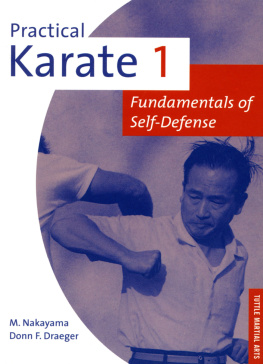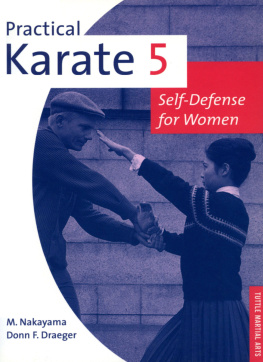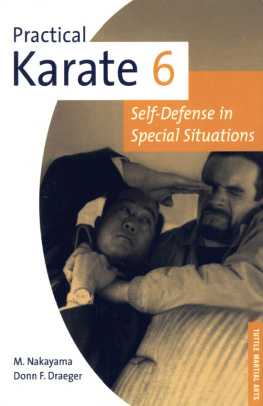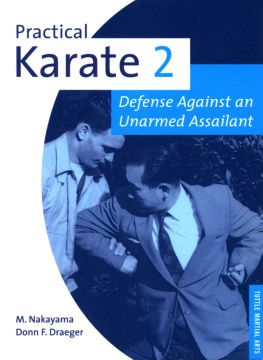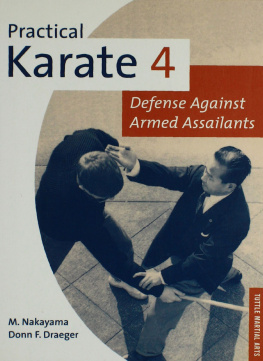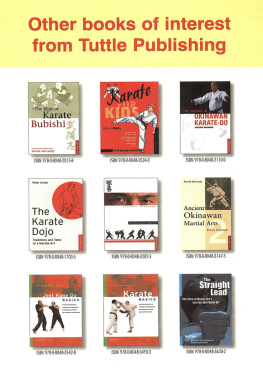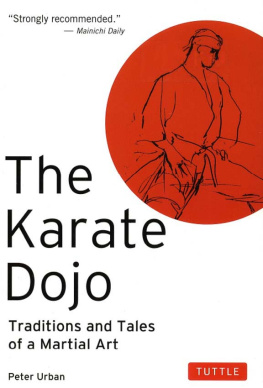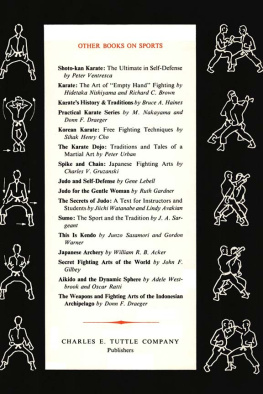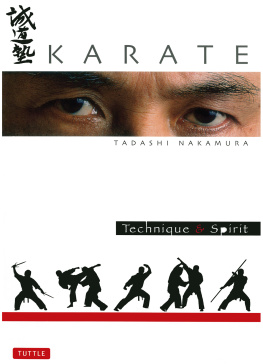The adoption and application of the material offered in this book is at the reader's discretion and sole responsibility. The Author and Publisher of this book are not responsible in any manner whatsoever for any injury that may occur indirectly or directly from the use of this book. Since the physical activities described herein may be too strenuous in nature for some readers to engage in safely, please consult a physician prior to training. The specific self-defense practices illustrated in this book may not be justified in every particular situation or under applicable federal, state or local law. Neither the Author or the Publisher make any warranty or representation regarding the legality or appropriateness of any technique mentioned in this book.
Copyright 1963 by Charles E. Tuttle Co., Inc. with editorial offices at 364 Innovation Drive, North Clarendon, VT 05759 U.S.A.
Copyright renewed 1991 by Charles E. Tuttle Co., Inc.
All rights reserved. No part of this publication may be reproduced or utilized in any form or by any means, electronic or mechanical, including photocopying, recording, or by any information storage and retrieval system, without prior written permission from Tuttle Publishing.
AUTHORS' FOREWORD
THERE IS, perhaps, no greater disservice to man than the creation of false confidence in his ability to defend himself. Whether this false confidence is manifested in his nations' armed might, or in his own personal ability, the result is the same, though of different proportions, when tested... DISASTER!
The current karate "boom" in the U.S.A. has instilled in many would-be "experts" a serious, false sense of security. This is the natural outgrowth of a human psychological weakness. Everyone wishes to be physically fit and able to defend himself and his loved ones from danger, and quickly turns to any sure-fire guarantee of such abilities.
Unscrupulous and unqualified self-appointed karate "experts" daily exploit this human weakness and prey on an innocent, unsuspecting public. This grossly perpetrated fraud is based on the quick learning of ancient mysterious Oriental combative forms such as karate, and almost always makes its appeal through colorful adjectives such as "super," "destructive," "terror tactics," and guarantees you mastery which will make you "fear no man." All such "get skillful quickly" schemes should be carefully investigated before choosing, for true karate involves constant dedication to training and is never a "short course" method. Choose your instructor carefully.
On the other hand, authentic teachers of karate do exist in the U.S.A., and their teachings have full merit. These teachings are deeply rooted in traditional, classical karate and require a liberal application of patience and regular training to develop expert karate skill. There are various schools which stem from historic Oriental antiquity, all of which are legitimate and have both merits and shortcomings. The choice of which school to follow can be decided only by the interested party.
The average person is confined to a daily life which requires of him a heavy investment in time and energy i n order to earn a living. Leisure time is generally at a minimum and spent at less enervating pursuits than demanded by classical karate practice. But the need for a practical system of self-defense designed for the average person is more evident than ever before. Police files give mute testimony to the increasing number of robberies, assaults, and other vicious crimes.
In this book the necessary karate fundamentals are pictorially laid out in an easy, readable fashion. It is a book which in theory must proceed any actual ability with karate technique. Use it to build skills for efficient karate responses in self-defense situations. This will require some practice on your part: at least several times per week for short periods of time. When you have practiced all the movements described in this book and can perform them automatically, you will have a sound foundation on which to build self-defense skills. However, it is not necessary that you completely study and practice all the movements of this book before turning to the actual defense skills in volumes two, to six. You may "learn as you go," taking each self-defense situation in any order from the other books in this series, using this volume as a reference to the necessary skills which the self-defense response requires. Either way, you must practice.
The authors arc indebted to the Japan Karate Association, Tokyo, Japan, for the use of their facilities and hereby acknowledge with pleasure the assistance of those members and officials who have made this book possible. Additional thanks is due to the excellent photographic skills of Akira Kasahara which has given this book its illustrations; to H. Shoji, an instructor of the Japan Karate Association, and to James S. Bregman, a student of combative arts whose posing for the "assailant" part of this text has been invaluable.

PREFACE
KARATE is a martial art developed by people who were prohibited the use of weapons, thus making it a defensive art. When one is attacked, the empty hands (which the word karate implies) are quite sufficient to defend oneself if one is highly skilled in the art. However, to become highly skilled takes exacting discipline, both mental and physical. The main purpose of this series of four books is to avoid the advanced techniques of karate which require many years of study and instead to describe simplified karate technique as easy-to-learn responses to typical self-defense situations.
Karate is highly esteemed as a sport, self-defense, and as a physical attribute for athletics in general. It is becoming increasingly popular in schools, offices, factories, law enforcement agencies and the armed services, varying in degree as required by the respective wants and needs.
In response to the many requests for treatment of karate purely as a defensive system, it is hoped that the information contained in this series of six books will be more than sufficient to meet these requests. In conclusion, if readers of this series of books will fully understand the principles and ideals of karate, taking care to use its techniques with discretion, they will reflect great credit to this magnificent art.

